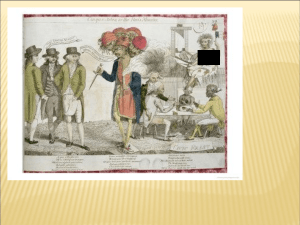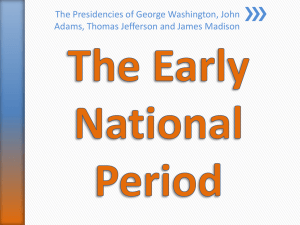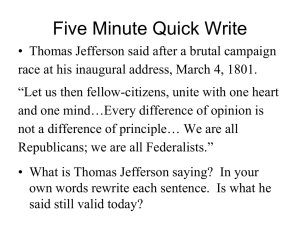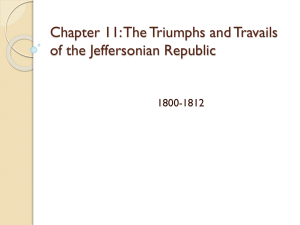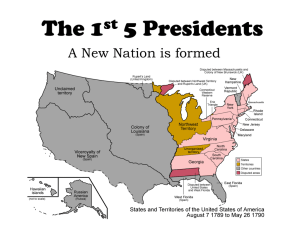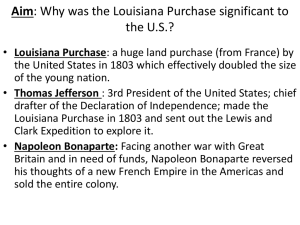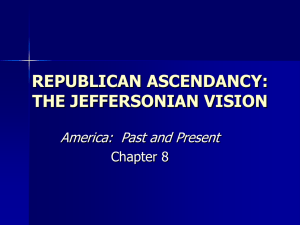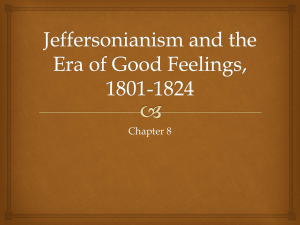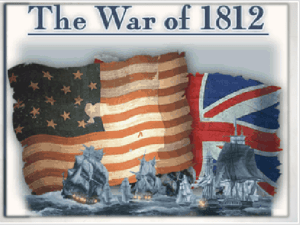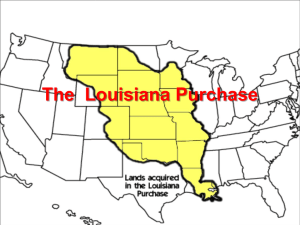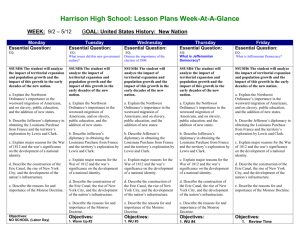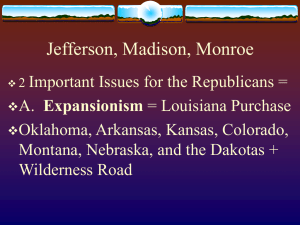Lecture 7b - Upper Iowa University
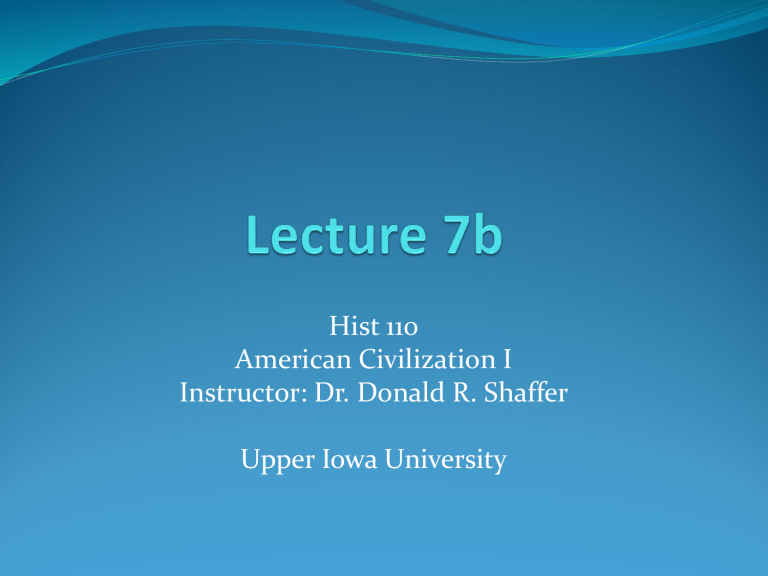
Hist 110
American Civilization I
Instructor: Dr. Donald R. Shaffer
Upper Iowa University
Lecture 7b
Jefferson Takes Over
Election of 1800
Thomas Jefferson prevailed over Aaron
Burr in the House of Representative
Led to the 12 th Amendment joining the vote for President and Vice President
Jefferson’s inaugural: took a conciliatory stance toward the Federalists
His agenda:
Cut government spending
Eliminate internal federal taxes and pay off the national debt
Passive approach to economic policy
Selective removal of Federalists in appointive offices (only 69 of 433)
Judiciary Act of 1801: Republicans repeal act packing the judiciary with Federalists
Republicans fail at using impeachment to remove Federalist judges—unable to oust arch-
Federalist Samuel Chase
What did Jefferson mean by the statement in his inaugural address:
“We are all Federalists.
We are all Republicans.”
Lecture 7b
Westward Expansion Under Jefferson
Westward expansion sped up after 1783
By 1800, nearly a million Americans lived west of Appalachian crest
Movement encouraged by federal government, particularly with the use of
U.S. army to force out Native Americans
Louisiana Purchase (1803)
Treaty of San Ildefonso (1800): Spain forced by Napoleon to cede Louisiana, which threatened American commerce on the Mississippi River
Jefferson offered to buy New Orleans from France to fix this problem
Napoleon, suddenly needing money, offered to sell all of Louisiana to U.S.
(828,800 sq. miles of territory)
Jefferson’s quandary: reconcile purchase with strict construction of Constitution
Jefferson decided to allow the voters to judge the constitutionality of purchase in the 1804 presidential election
Map of the
Louisiana Purchase
(in deep green)
Lecture 7b
Forces Underlying Westward Expansion
Two forces underlay Westward expansion in the decades following the
American Revolution
Yeoman farmers both in the North and
South trying to maintain their independence in the face of growing land scarcity on the eastern seaboard
The movement of commercial agriculture, especially southern planters, looking for fresh land
The boom in cotton cultivation after the invention of the cotton gin spurred the movement of planters west as cotton quickly exhausted soil
Federal land policy, which initially required large purchases for cash, meant that much of western land ended up in the hands of speculators
Speculators found themselves having to deal with squatters
Growing land scarcity, worn out land, and labor departed for the frontier, forced eastern farmers to introduce progressive agricultural techniques
George Caleb Bingham’s famous painting of Daniel Boone escorting settlers through the Cumberland Gap
Lecture 7b
Jefferson’s Difficult Second Term
Jefferson easily re-elected in 1804, but afterwards his fortunes suffered
Political troubles:
Fallout from Vice President Aaron Burr killing Alexander Hamilton in a duel
The Quids: a ultra-pure faction within
Jefferson’s Republicans
James T. Callender: exposed Jefferson’s sexual relationship with his slave, Sally
Hemings
Impressment
Collapse of Peace of Amiens in 1803
British began stopping U.S. ships and forcing American sailors to serve in the
Royal Navy
Non-Importation Act (1806): U.S. resorted to trade pressure to end British practice of impressment
Embargo Act (1807): failure of nonimportation, the Chesapeake Affair, and New England’s resistance caused
Jefferson to ask for a cessation of all
U.S. imports and exports
Lecture 7b
Origins of the War of 1812
James Madison succeeded Jefferson as president in March 1809
Jefferson left the presidency unpopular because of his harsh and unsuccessful policies to end impressment
Madison also failed to end impressment
Non-Intercourse Act (1809)
Macon’s Bill No. 2 (1810)
Roots of Anglo-American conflict
Misunderstanding each others view of the world and their place in it—Americans wanted their neutral rights respected while British and French thought weak nations like the U.S. must ally themselves with a great power for their own protection
War Hawks
Up and coming politicians like Henry
Clay and John C. Calhoun who pushed for war because they felt it was the only way for the U.S. to reclaim its honor
Henry Clay
Napoleon Bonaparte
Who cheated the U.S.
in the implementation of Macon’s Bill No. 2
John C. Calhoun
Lecture 7b
War of 1812 (1)
June 19, 1812: War declared
Madison accused Britain violating U.S. neutral rights
Claimed also Britain was inciting Native
American attacks on the frontier
Some Americans coveted Canada
U.S. divided on war
South and West pro-war
New England anti-war
They had strong trade ties to the
British Empire
U.S. ill-prepared for war
Navy: 6 frigates, 3 sloops: even with the use of privateers not even close enough to the strength needed take on the Royal
Navy
U.S. Army: never larger than 35,000 during war
Yet the U.S. lack of preparation was offset for most of the war by the fact that the British were in 1812 still heavily engaged in their war with France
American propaganda poster from the War of 1812
What does it say about
American self perception?
Lecture 7b
War of 1812 (2)
U.S. offense: 1812-1814.
American forces repeatedly invaded
Canada—and repeatedly failed
Some U.S. victories
Put-in-Bay: naval victory on Lake Erie
Battle of the Thames in which the
Indian leader Tecumseh was killed
British offensive: 1814-1815
Invasion from Canada stopped on Lake
Champlain
Chesapeake campaign
Washington, D.C. burned in retaliation for U.S. burning Toronto
Fort McHenry: successful defense saved Baltimore and inspired the national anthem
Treaty of Ghent (December 1814):
With the end of the Napoleonic War the underlying causes of the war ended making a status quo settlement possible
American victory at the Battle of
New Orleans that took place after the peace treaty ending the war
American victory in the battle helped disguise that war had been a near disaster for the U.S.
